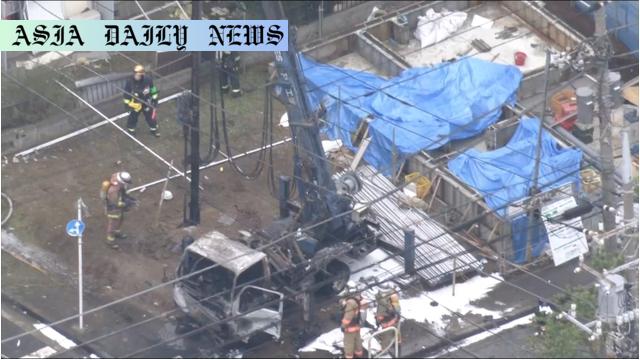Explosion: Investigators suspect a buried gas cylinder caused a shocking blast in Tokyo’s Edogawa Ward, injuring 10 people.
- An explosion in Tokyo’s Edogawa Ward injured 10 and damaged nearly 40 buildings.
- A buried acetylene gas cylinder may have caused the blast at a construction site.
- Authorities temporarily evacuated residents and deployed over 30 fire engines.

Explosion at Tokyo Construction Site Injures Residents
Details of the Incident
In Tokyo’s bustling Edogawa Ward, a condominium construction site turned into a shocking scene of destruction on Tuesday morning. An explosion left 10 individuals injured and caused significant damage to 38 nearby buildings. Initial investigations suggest that a buried gas cylinder, specifically one designed for acetylene gas, was the likely cause of the blast. Acetylene gas is commonly used in welding metals, and its highly flammable nature makes it particularly dangerous when exposed improperly.
The explosion occurred during pile driving operations at the construction site. A subsequent fire broke out, engulfing a truck located at the site. The fire continued for four hours before being fully extinguished with the aid of over 30 fire engines and emergency personnel. The blast not only injured construction workers but also affected local residents living in close proximity. Victims reported pain in their ears and throats, though injuries were fortunately minor.
Extent of the Damage
The extent of the damage has raised concerns about safety protocols at construction sites. The explosion shattered windows, destroyed walls, and caused significant structural damages to a convenience store, several houses, and other nearby shops. Police cordoned off the area and called for temporary evacuation of residents within a 100-meter radius of the blast. This was a precautionary measure considering the volatile nature of gas leaks and the risk of secondary explosions. The site is situated near Kasai Station on Tokyo Metro’s Tozai Line, an area known for its residential density.
Environmental and Safety Concerns
One of the biggest questions arising from this incident is why such a dangerous gas cylinder was buried underground in the first place. Investigators are striving to determine whether the cylinder may have been left there accidentally or intentionally. Construction firms often face strict regulations for handling combustible substances, and this incident may prompt a closer examination of such practices across the construction sector. Moreover, it underscores the importance of proper safety inspection in urban areas, where even minor negligence can have widespread repercussions.
Emergency Response and Evacuations
The Tokyo Fire Department and local police were swift in their response. Authorities coordinated efforts to contain the situation promptly, ensuring there were no casualties despite the damages. Residents nearby were alerted to evacuate due to potential risks from the gas leak and subsequent fire. While such emergency measures are standard protocol, the need for proactivity in high-density urban zones becomes even more apparent in light of such incidents.
Long-Term Implications
This incident serves as a grim reminder of how urban construction, if not managed diligently, can pose unforeseen risks to both workers and communities at large. Enhanced regulations and thorough site inspections could help prevent similar occurrences. Additionally, better coordination between the construction industry and safety authorities is crucial in ensuring the safe development of urban infrastructure. As Tokyo continues its expansion as a global metropolitan hub, such incidents highlight the vital need for implementing safer, more reliable construction practices.



Commentary
Reflection on Urban Safety Following Tokyo Blast
The explosion in Edogawa Ward is a stark reminder of the potential dangers linked to urban construction and the importance of stringent safety protocols. Tokyo, a city that seamlessly blends its historical charm with modern infrastructure, often relies on its efficiency and preparedness. However, incidents like these expose vulnerabilities that require urgent attention from authorities and industries alike.
Concerns About Negligence
The discovery of a buried acetylene gas cylinder raises critical questions about negligence at construction sites. Was this an isolated oversight, or is it indicative of a deeper issue within industry practices? It’s common knowledge that acetylene gas is highly flammable, which makes the presence of such a cylinder particularly alarming. Investigation into this matter will not only clarify the current situation but may also set a precedent for stricter monitoring on future construction projects.
Importance of Proactive Safety Measures
What truly stands out from this incident is the remarkable response by Tokyo’s emergency services. Deploying over 30 fire engines and safely evacuating residents is a commendable step in ensuring public safety. However, reliance on reactive measures isn’t enough. The frequency of urban construction across Tokyo and similar global metropolises makes it imperative to adopt proactive safety measures, such as thorough site surveys and enhanced worker training programs.
Learning from the Incident
Ultimately, the Edogawa explosion should serve as a wake-up call for all stakeholders involved in urban development. Carelessness in handling hazardous materials in densely populated areas has dire consequences, and every precaution should be in place to prevent them. While it’s a relief that the injuries were non-fatal this time, the incident must be viewed with seriousness, prompting a broader dialogue about construction safety and community welfare.